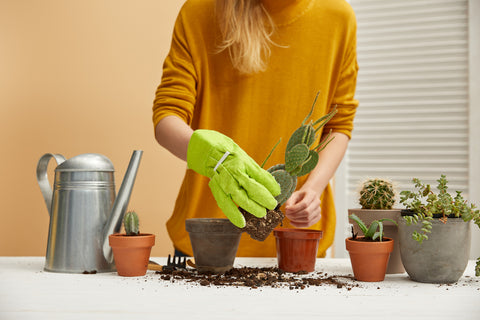
Growing Cactus from seeds
Growing Cactus from seeds
Growing Cacti from seeds can be a fun, rewarding, and satisfying hobby for plant enthusiasts and hobby gardeners. Cactus plants are quite well known for their unique appearance and ability to thrive in hot, dry environments. These features make them a popular choice for indoor and outdoor gardens everywhere. While cactus plants can be propagated easily from cuttings, growing them from seeds will allow for greater diversity in the types of cactus that can be grown.
Growing a Cactus from seeds can be a cost-effective way of creating your very own collection of these interesting and attractive plants. In this Cactus growing guide, we will explain the steps for growing a cactus from seeds, including choosing the right seeds, preparing and sowing the seeds, and caring for your little seedlings. Whether you are a green-fingered plant expert or a novice gardener, growing cactus from seeds can be a fun and rewarding project.
Benefits of growing cactus from seeds
There are quite a few benefits of growing cacti from seeds.
- Firstly, growing Cactus from seeds can be cost-effective: Starting cactus from seeds is often cheaper than purchasing an established Cactus plant.
- Greater diversity: Growing cactus from seeds allows for a greater variety of cactus plants to be grown, as seedlings may produce different characteristics and features than the parent plant.
- Personal accomplishment: There is a sense of personal accomplishment and joy that comes with successfully growing a cactus plant from seeds. It will be your very own plant which you have cared for from seed and will live for decades to come.
Types of cactus seeds to consider
When growing Cactus from seeds, it is important to select the right variety of plants. There are many types of cactus seeds that are relatively easy to germinate. For example, Barrel cactus seeds have a hard outer coating that needs to be nicked or scarified so that water can penetrate it. While Christmas cactus seeds have a fleshy outer coating that needs to be removed before sowing in the soil. Moon cactus seeds have a thin, papery outer coating and should be sown on top of a well-draining soil mix, while prickly pear cactus seeds have a hard outer coating and should be soaked in water for a few days before planting to help speed up germination.
It is quite important to research and follow germination instructions for the type of cactus seeds you are planting, as different types of Cactus may have different requirements.
Where to purchase cactus seeds
Not all cactus seeds are created equal. Just like with any living thing, some seeds may be old or of poor quality. This can make them less likely to germinate. By choosing a reputable source for your seeds such as Grow Buddha, you can be more confident in their quality. Some sellers may mix cactus seeds with seeds from other plants, which can make it difficult to know exactly what you are getting. Buying from a reputable source can help ensure that the seeds you receive are pure and of the variety you expect.
Preparing and Sowing the seeds
Here are a few steps for preparing cactus seeds for planting:
- Choose the right seeds: Select high-quality, pure cactus seeds from a reputable source such as Grow Buddha.
- Soak the seeds: Depending on the type of Cactus seeds, some cactus seeds have a hard outer coating that needs to be softened before planting. In order to do this, you can soak the seeds in water for a few days or use a technique called "scarification," which involves lightly scratching the surface of the seed with a file or sandpaper. In some cases, the Cactus seeds can be extremely tiny and you can plant them directly.
- Stratify the seeds: Some cactus seeds require a period of cold stratification in order to germinate. This can be achieved by placing the seeds in a moist paper towel and storing them in the refrigerator for several weeks.
- Sow the seeds: Once the seeds are prepared, they can be sown on top of a well-draining soil mix. Cover the seeds lightly with soil and keep them moist and somewhere warm until they germinate.
- Transplant the seedlings: Once the seedlings have developed their first set of true leaves, they can be transplanted into individual pots or into the ground to avoid competing against each other.

Watering and Feeding
Feeding and watering cactus plants is a crucial part of growing a Cactus plant. Cactus plants are naturally adapted to survive in dry environments and do not require frequent watering. Lazy gardeners are lucky in this regard. In fact, overwatering is one of the most common causes of cactus death. During the growing season, cactus plants should be watered deeply, allowing the soil to dry out completely before watering again. In the winter, watering should be reduced or stopped altogether. Don’t worry, your Cactus won't die if you don’t water them often. Cactus plants can be fertilized during the growing season with a balanced fertilizer such as the Grow Buddha Cactus food. However, it is important to follow the instructions and not over-fertilize. Too much fertilizer can cause cactus plants to grow too quickly and become weak.
Ideal Soil for Cactus
The best type of soil for cactus plants is a well-draining soil mix that allows excess water to quickly drain away. Cactus plants naturally grow in dry environments and are prone to rot if the soil is too wet/moist. A good soil mix for cactus plants should contain a combination of soil, sand, and perlite or pumice to improve drainage. We advise against using regular potting soil, as it retains too much water and can lead to root rot. A cactus soil mix such as Grow Buddha cactus and succulent soil can provide the necessary nutrients for cactus plants to thrive.
Cactus Pests and diseases
Cactus plants are quite tough little things. They are much more resistant to pests and diseases than other plants, however, they can still be affected by various issues. Some common pests that can affect cactus plants include aphids, mealybugs, and scale insects. As with most pests, these can be controlled through the use of insecticides or by manually removing them from the plant. Cactus plants can also be affected by fungal diseases, such as root rot and powdery mildew. Do not fear, Fungal diseases can also be prevented by ensuring that the plants are grown in well-draining soil and by avoiding overwatering. If your beloved cactus plant is infected with a fungal disease, it may need to be treated with a fungicide or removed to prevent the disease from spreading to other plants.
